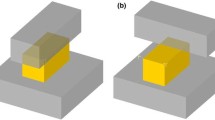Abstract
A numerical analysis was performed to study the influence of process parameters on the microstructure evolution of IN718 alloy in rotary forging using the finite element method (FEM). For this purpose, a constitutive equation considering the effects of strain hardening and dynamic softening of IN718 alloy was built. The constitutive equation and microstructure models were implemented into the finite element code to investigate the microstructure evolution during rotary forging subject to large deformations. The simulations were carried out in the ratio of initial height to diameter range 0.2–0.8, the angle of the rocker 3°-7° and the relative feed per revolution range 0.01–0.1 r−1. The research results revealed the deformation mechanism and the correlation of process parameters with the grain size evolution of IN718 alloy during rotary forging. These provide evidence for the selection of rotary forging parameters.
Similar content being viewed by others
References
Liu G, Zhang L B, Hu X L. Applications of numerical simulation to analysis of bulk-forming processes-case studies [J]. Journal of Materials Processing Technology, 2004, 150: 56–61.
Wang G C, Zhao G Q. Simulation and analysis of rotary forging a ring workpiece using finite element method [J]. Finite Elements in Analysis and Design, 2002, 38: 1151–1164
Jang Y S, Ko D C, Kim B M. Application of the finite element method to predict microstructure evolution in the hot forging of steel [J]. Journal of Materials Processing Technology, 2000, 101: 85–94.
Park N K, Kim I S, Na Y S. Hot forging of a nickel-base superalloy [J]. Journal of Materials Processing Technology, 2001, 111: 98–102.
Cho J R, Jeong H S. Prediction of microstructural evolution and recrystallization behaviors of a hot working die steel by FEM [J]. Journal of Materials Processing Technology, 2005, 160: 1–8.
Cho J R, Bae WB. A study on the hot-deformation behavior and dynamic recrystallization of Al-5 wt.%Mg alloy [J]. Journal of Materials Processing Technology, 2001, 118: 356–361.
Grass H, Krempaszky C, Werner E. 3-D Simulation of hot forming and microstructure evolution [J]. Computational Materials Science, 2003, 28: 469–477.
Sinczak J, Majta J, Glowacki M, et al. Prediction of mechanical properties of heavy forgings [J]. Journal of Materials Processing Technology, 1998, 80: 166–173.
Park J J. Prediction of the flow stress and grain size of steel during thick-plate rolling [J]. Journal of Materials Processing Technology, 2001, 113: 581–586.
Bontcheva N, Petzov G. Microstructure evolution during metal forming processes [J]. Computational Materials Science, 2003, 28: 563–573.
Wang L S, Ma X T. Numerical simulation and experimental analysis on dynamic recrystallization during three dimensional hot forging [J]. Chinese Journal of Mechanical Engineering, 1996, 32: 4–29.
Hartley P, Pillinger I. Numerical simulation of the forging process [J]. Computer Methods in Applied Mechanics and Engineering, 2006, 195: 6676–6690.
Medeiros S C, Prasad Y V R K, Frazier WG, et al. Microstructural modeling of metadynamic recrystallization in hot working of IN718 superalloy [J]. Materials Science and Engineering A, 2000, 293: 198–207.
Huang C, Hawbolt E B, Chen X, et al. Flow stress modeling and warm rolling simulation behavior of two Ti-Nb interstitial-free steels in the ferrite region [J]. Acta Material, 2001, 49: 1445–1452.
Jeong H S, Cho J R, Park H C. Microstructure prediction of Nimonic 80A for large exhaust valve during hot closed die forging [J]. Journal of Materials Processing Technology, 2005, 162: 504–511.
Na Y S, Yeom J T, Park N K, et al. Simulation of microstructures for Alloy 718 blade forging using 3D FEM simulator [J]. Journal of Materials Processing Technology, 2003, 141: 337–342.
Author information
Authors and Affiliations
Corresponding author
Additional information
Foundation item: the National Basic Research Program (973) of China (No. 2006CB705400).
Rights and permissions
About this article
Cite this article
Yu, Zq., Ma, Q. & Lin, Zq. Simulation and analysis of microstructure evolution of IN718 in rotary forgings by FEM. J. Shanghai Jiaotong Univ. (Sci.) 13, 721–726 (2008). https://doi.org/10.1007/s12204-008-0721-4
Received:
Published:
Issue Date:
DOI: https://doi.org/10.1007/s12204-008-0721-4




